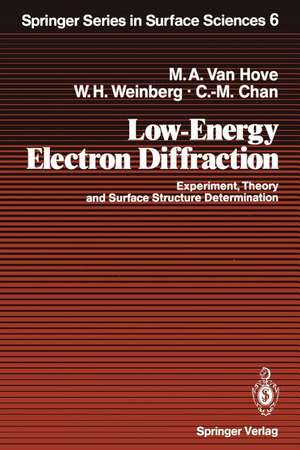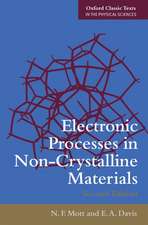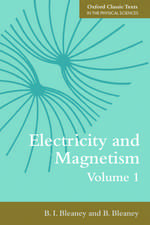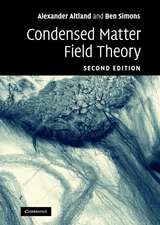Low-Energy Electron Diffraction: Experiment, Theory and Surface Structure Determination: Springer Series in Surface Sciences, cartea 6
Autor Michel A. Vanhove, William Henry Weinberg, Chi-Ming Chanen Limba Engleză Paperback – 15 dec 2011
Din seria Springer Series in Surface Sciences
- 18%
 Preț: 1131.25 lei
Preț: 1131.25 lei - 15%
 Preț: 654.77 lei
Preț: 654.77 lei - 18%
 Preț: 1113.09 lei
Preț: 1113.09 lei -
 Preț: 390.63 lei
Preț: 390.63 lei -
 Preț: 407.98 lei
Preț: 407.98 lei - 15%
 Preț: 657.57 lei
Preț: 657.57 lei - 15%
 Preț: 636.63 lei
Preț: 636.63 lei - 15%
 Preț: 641.20 lei
Preț: 641.20 lei - 15%
 Preț: 651.19 lei
Preț: 651.19 lei - 15%
 Preț: 645.60 lei
Preț: 645.60 lei - 15%
 Preț: 632.70 lei
Preț: 632.70 lei - 15%
 Preț: 640.24 lei
Preț: 640.24 lei - 15%
 Preț: 646.11 lei
Preț: 646.11 lei -
 Preț: 397.38 lei
Preț: 397.38 lei -
 Preț: 386.22 lei
Preț: 386.22 lei -
 Preț: 387.75 lei
Preț: 387.75 lei -
 Preț: 389.31 lei
Preț: 389.31 lei -
 Preț: 399.12 lei
Preț: 399.12 lei -
 Preț: 406.42 lei
Preț: 406.42 lei - 18%
 Preț: 1011.14 lei
Preț: 1011.14 lei - 18%
 Preț: 2100.88 lei
Preț: 2100.88 lei -
 Preț: 398.35 lei
Preț: 398.35 lei -
 Preț: 392.21 lei
Preț: 392.21 lei -
 Preț: 389.88 lei
Preț: 389.88 lei - 15%
 Preț: 646.43 lei
Preț: 646.43 lei - 15%
 Preț: 643.16 lei
Preț: 643.16 lei - 15%
 Preț: 643.65 lei
Preț: 643.65 lei - 18%
 Preț: 948.79 lei
Preț: 948.79 lei - 15%
 Preț: 641.03 lei
Preț: 641.03 lei - 15%
 Preț: 640.55 lei
Preț: 640.55 lei - 15%
 Preț: 640.71 lei
Preț: 640.71 lei - 18%
 Preț: 952.72 lei
Preț: 952.72 lei - 18%
 Preț: 955.08 lei
Preț: 955.08 lei - 15%
 Preț: 648.42 lei
Preț: 648.42 lei - 15%
 Preț: 641.03 lei
Preț: 641.03 lei - 18%
 Preț: 1000.42 lei
Preț: 1000.42 lei - 18%
 Preț: 952.57 lei
Preț: 952.57 lei - 18%
 Preț: 1001.02 lei
Preț: 1001.02 lei
Preț: 407.01 lei
Nou
Puncte Express: 611
Preț estimativ în valută:
77.88€ • 81.52$ • 64.82£
77.88€ • 81.52$ • 64.82£
Carte tipărită la comandă
Livrare economică 31 martie-14 aprilie
Preluare comenzi: 021 569.72.76
Specificații
ISBN-13: 9783642827235
ISBN-10: 3642827233
Pagini: 624
Ilustrații: XVIII, 604 p.
Dimensiuni: 155 x 235 x 33 mm
Greutate: 0.86 kg
Ediția:Softcover reprint of the original 1st ed. 1986
Editura: Springer Berlin, Heidelberg
Colecția Springer
Seria Springer Series in Surface Sciences
Locul publicării:Berlin, Heidelberg, Germany
ISBN-10: 3642827233
Pagini: 624
Ilustrații: XVIII, 604 p.
Dimensiuni: 155 x 235 x 33 mm
Greutate: 0.86 kg
Ediția:Softcover reprint of the original 1st ed. 1986
Editura: Springer Berlin, Heidelberg
Colecția Springer
Seria Springer Series in Surface Sciences
Locul publicării:Berlin, Heidelberg, Germany
Public țintă
ResearchCuprins
1. The Relevance and Historical Development of LEED.- 1.1 The Relevance of Surface Crystallography.- 1.2 The Historical Development of LEED.- 2. The LEED Experiment.- 2.1 General Features of LEED Experiments.- 2.2 Sample Mounting.- 2.3 Electron Gun and Display System.- 2.4 Methods of Data Acquisition.- 2.5 Instrumental Response Function.- 2.6 Determination of Angle of Incidence.- 2.7 Determination of the Debye Temperature.- 3. Ordered Surfaces: Structure and Diffraction Pattern.- 3.1 Two-Dimensional Periodicity and the LEED Pattern.- 3.2 Superlattices at Surfaces.- 3.3 Stepped and Kinked Surfaces.- 3.4 Symmetries and Domains at Surfaces.- 3.5 Interpretation of LEED Patterns.- 4. Kinematic LEED Theory and Its Limitations.- 4.1 Definition of Kinematic Theory.- 4.2 The Kinematic Structure Factor for Ordered Surfaces.- 4.3 The Scattering Processes in LEED.- 4.4 The Elastic Scattering Potential.- 4.5 Atomic Scattering.- 4.6 The Inner Potential and the Muffin-Tin Constant.- 4.7 Temperature Effects.- 4.8 From Kinematic to Dynamical LEED.- 5. Dynamical LEED Theory.- 5.1 Multiple Scattering.- 5.2 Diffraction in Crystalline Lattices.- 5.3 Multiple Scattering in the Spherical-Wave Representation — Self-Consistent Formalism.- 5.4 Perturbation Expansion of Multiple Scattering in the Spherical-Wave Representation: Reverse-Scattering Perturbation (RSP) Method.- 5.5 Diffraction by a Stack of Layers: Transfer-Matrix and Bloch-Wave Method.- 5.6 Diffraction by a Stack of Layers: Layer-Stacking and Layer-Doubling Method.- 5.7 Diffraction by a Stack of Layers: Renormalized-Forward-Scattering (RFS) Perturbation Method.- 5.8 Efficiency of Computation and the Combined-Space Method.- 5.9 Superlattices and Domains.- 5.10 Symmetries.- 5.11 Thermal Effects.- 5.12 Potential Steps, Surface States,Surface Resonances and LEED Fine Structure.- 5.13 Relativistic and Spin-Dependent Effects in LEED.- 5.14 Some Other Theoretical Techniques.- 5.15 Outstanding Theoretical Problems in LEED.- 5.16 Application of LEED Theory to Other Electron Spectroscopies.- 5.17 Computer Programs.- 6. Methods of Surface Crystallography by LEED.- 6.1 The Kinematic Approach to Surface Crystallography.- 6.2 Averaging Methods.- 6.3 Fourier-Transform Methods.- 6.4 The Dynamical Approach to Surface Crystallography.- 6.5 Reliability Factors (R-Factors).- 6.6 Accuracy and Precision of Structural Determination.- 7. Results of Structural Analyses by LEED.- 7.1 Clean Unreconstructed Surfaces.- 7.2 Reconstructed Surfaces.- 7.3 Adsorbed Atomic Layers.- 7.4 Adsorbed Molecular Layers.- 8. Two Dimensional Order-Disorder Phase Transitions.- 8.1 Introduction to Order-Disorder Phase Transitions at Surfaces...- 8.2 The Interaction of Hydrogen with the (111) Surface of Nickel.- 8.3 The Interaction of Hydrogen with the (100) Surface of Palladium.- 8.4 The Interaction of Hydrogen with the (110) Surface of Iron.- 9. Chemical Reactions at Surfaces and LEED.- 9.1 Monitoring Surface Reactions by LEED.- 9.2 The Adsorption of Oxygen on Rh(111) at 335 K.- 9.3 The Reaction Between Hydrogen and Ordered Oxygen on Rh(111).- 9.4 The Reaction Between Hydrogen and Both Ordered and Disordered Oxygen on Rh(111).- 10. Island Formation of Adspecies and LEED.- 10.1 The Nature of Islands on Surfaces.- 10.2 LEED Beam Profiles for Arrays of Ordered Islands.- 10.3 Island Formation in a Real System: CO on Ru(0001).- 11. The Future of LEED.- 11.1 Experimental Outlook.- 11.2 Theoretical Outlook.- 11.3 Progress in Structural Determination.- 11.4 LEED vs. Other Surface-Sensitive Techniques.- 12. Reference List and Table for Surface Structures.- Appendix A: Acronyms of Techniques Related to Surface Science.- Appendix B: A Computer Program to Determine the Angle of Incidence in LEED.- List of Major Symbols.- References.

















